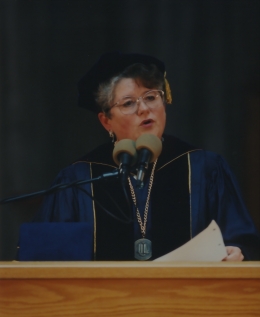
2014, 170 pages
The Regional History Project conducted this oral history with UCSC Chancellor M.R.C. (Mary Rita Cooke) Greenwood as part of its University History series. Greenwood was appointed as chancellor of UC Santa Cruz in July of 1996 and served until April of 2004. While at UCSC, she also held an appointment as a professor of biology.
M.R.C. Greenwood was born in 1943 in Gainesville, Florida. She graduated summa cum laude in biology from Vassar College in 1968, and earned her PhD in physiology, developmental biology, and neurosciences from Rockefeller University in 1973. After graduation, she joined the faculty in human nutrition at Columbia University’s Medical School, where she taught until 1978, when she moved to Vassar College. At Vassar she was the John Guy Vassar Professor of Natural Sciences, chaired the department of biology, and directed the Undergraduate Research Summer Institute. In 1989, Greenwood was hired by the University of California at Davis, where she was professor of nutrition and internal medicine, served as dean of graduate studies, and later vice provost for academic outreach. Her research interests are in developmental cell biology, genetics, neurosciences, physiology, women´s health, nutrition and science, and higher education policy.
From November 1993 to May 1995, while on leave from UC Davis, Greenwood served as associate director for science in the White House Office of Science and Technology Policy under President Bill Clinton. She spearheaded the creation of two major science policy documents: “Science in the National Interest” and “Meeting the Challenge: Health, Safety, and Food for America.” In addition, she played a leadership role in coordinating interdepartmental and interagency science activities and co-chaired two National Sciences and Technology Council committees.
The political savvy she developed in the White House, as well as her experience in the world of government-funded scientific research, was to greatly benefit the UC Santa Cruz campus. Under her leadership, the campus finally established its first professional school, the Jack Baskin School of Engineering, which had been planned since the days of Chancellor Dean McHenry, but cut for budgetary reasons. Her years also saw many other strides forward: the founding of the NSF Center for Adaptive Optics; an increase in the number of academic programs by 52 percent, from 63 to 96, including a 41 percent increase in graduate programs; the building and opening of Colleges Nine and Ten; the hiring of 250 new faculty members; and a doubling of extramural research support. Greenwood’s tenure also saw the construction of nearly one million assignable square feet in academic buildings for the arts, the sciences and engineering; the founding of a UC Silicon Valley Center at Moffett Field; and collaboration with NASA Ames in developing the nation´s first NASA University Affiliated Research Center, the largest competitively awarded contract ($330 million) at the University of California up to that time.
In addition, under Greenwood’s leadership the campus raised more in private donations than the previous total for the campus´s entire history. She built strong bridges with the city of Santa Cruz and surrounding communities, worked to preserve what she saw as the best aspects of the UCSC residential college system, and to diversify the student body and faculty even in the wake of Proposition 209 and other backlashes against affirmative action. In this oral history she discusses her own experience as the first woman chancellor of UCSC and being part of the first generation of women to hold senior leadership positions in higher education administration.

 Santa Cruz, CA
Santa Cruz, CA



